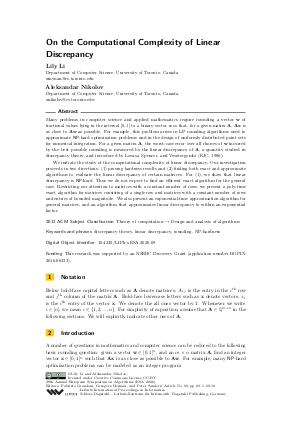On the Computational Complexity of Linear Discrepancy
Authors Lily Li, Aleksandar Nikolov
-
Part of:
Volume:
28th Annual European Symposium on Algorithms (ESA 2020)
Part of: Series: Leibniz International Proceedings in Informatics (LIPIcs)
Part of: Conference: European Symposium on Algorithms (ESA) - License:
 Creative Commons Attribution 3.0 Unported license
Creative Commons Attribution 3.0 Unported license
- Publication Date: 2020-08-26
File

PDF
LIPIcs.ESA.2020.69.pdf
- Filesize: 0.59 MB
- 16 pages
Document Identifiers
Subject Classification
ACM Subject Classification
- Theory of computation → Design and analysis of algorithms
Keywords
- discrepancy theory
- linear discrepancy
- rounding
- NP-hardness
Metrics
- Access Statistics
-
Total Accesses (updated on a weekly basis)
0Document
0Metadata
Abstract
Many problems in computer science and applied mathematics require rounding a vector 𝐰 of fractional values lying in the interval [0,1] to a binary vector 𝐱 so that, for a given matrix 𝐀, 𝐀𝐱 is as close to 𝐀𝐰 as possible. For example, this problem arises in LP rounding algorithms used to approximate NP-hard optimization problems and in the design of uniformly distributed point sets for numerical integration. For a given matrix 𝐀, the worst-case error over all choices of 𝐰 incurred by the best possible rounding is measured by the linear discrepancy of 𝐀, a quantity studied in discrepancy theory, and introduced by Lovasz, Spencer, and Vesztergombi (EJC, 1986). We initiate the study of the computational complexity of linear discrepancy. Our investigation proceeds in two directions: (1) proving hardness results and (2) finding both exact and approximate algorithms to evaluate the linear discrepancy of certain matrices. For (1), we show that linear discrepancy is NP-hard. Thus we do not expect to find an efficient exact algorithm for the general case. Restricting our attention to matrices with a constant number of rows, we present a poly-time exact algorithm for matrices consisting of a single row and matrices with a constant number of rows and entries of bounded magnitude. We also present an exponential-time approximation algorithm for general matrices, and an algorithm that approximates linear discrepancy to within an exponential factor.
Cite As Get BibTex
Lily Li and Aleksandar Nikolov. On the Computational Complexity of Linear Discrepancy. In 28th Annual European Symposium on Algorithms (ESA 2020). Leibniz International Proceedings in Informatics (LIPIcs), Volume 173, pp. 69:1-69:16, Schloss Dagstuhl – Leibniz-Zentrum für Informatik (2020)
https://doi.org/10.4230/LIPIcs.ESA.2020.69
BibTex
@InProceedings{li_et_al:LIPIcs.ESA.2020.69,
author = {Li, Lily and Nikolov, Aleksandar},
title = {{On the Computational Complexity of Linear Discrepancy}},
booktitle = {28th Annual European Symposium on Algorithms (ESA 2020)},
pages = {69:1--69:16},
series = {Leibniz International Proceedings in Informatics (LIPIcs)},
ISBN = {978-3-95977-162-7},
ISSN = {1868-8969},
year = {2020},
volume = {173},
editor = {Grandoni, Fabrizio and Herman, Grzegorz and Sanders, Peter},
publisher = {Schloss Dagstuhl -- Leibniz-Zentrum f{\"u}r Informatik},
address = {Dagstuhl, Germany},
URL = {https://drops.dagstuhl.de/entities/document/10.4230/LIPIcs.ESA.2020.69},
URN = {urn:nbn:de:0030-drops-129352},
doi = {10.4230/LIPIcs.ESA.2020.69},
annote = {Keywords: discrepancy theory, linear discrepancy, rounding, NP-hardness}
}
Author Details
Funding
This research was supported by an NSERC Discovery Grant (application number RGPIN-2016-06333).
References
-
Christoph Aistleitner, Dmitriy Bilyk, and Aleksandar Nikolov. Tusnády’s problem, the transference principle, and non-uniform qmc sampling. In Art B. Owen and Peter W. Glynn, editors, Monte Carlo and Quasi-Monte Carlo Methods, pages 169-180. Springer International Publishing, 2016.

-
Per Austrin, Venkatesan Guruswami, and Johan Håstad. (2+ε)-sat is np-hard. SIAM Journal on Computing, 46(5):1554-1573, 2017.

-
Nikhil Bansal, Ravishankar Krishnaswamy, and Viswanath Nagarajan. Better scalable algorithms for broadcast scheduling. ACM Trans. Algorithms, 11(1):3:1-3:24, 2014.

-
József Beck and Vera T Sós. Discrepancy theory. In Handbook of combinatorics (vol. 2), pages 1405-1446. MIT Press, 1996.

- Jean-Daniel Boissonnat, Micha Sharir, Boaz Tagansky, and Mariette Yvinec. Voronoi diagrams in higher dimensions under certain polyhedral distance functions. Discrete & Computational Geometry, 19(4):485-519, 1998. URL: https://doi.org/10.1007/PL00009366.
-
Moses Charikar, Alantha Newman, and Aleksandar Nikolov. Tight hardness results for minimizing discrepancy. In Proceedings of the twenty-second annual ACM-SIAM symposium on Discrete Algorithms, pages 1607-1614. Society for Industrial and Applied Mathematics, 2011.

-
Bernard Chazelle. An optimal convex hull algorithm in any fixed dimension. Discrete & Computational Geometry, 10(4):377-409, 1993.

-
Bernard Chazelle. The discrepancy method: randomness and complexity. Cambridge University Press, 2001.

-
E Mark Gold. Complexity of automaton identification from given data. Information and control, 37(3):302-320, 1978.

-
Venkatesan Guruswami, Daniele Micciancio, and Oded Regev. The complexity of the covering radius problem. Computational Complexity, 14(2):90-121, 2005.

-
Ishay Haviv and Oded Regev. Hardness of the covering radius problem on lattices. In Computational Complexity, 2006. CCC 2006. Twenty-First Annual IEEE Conference on, pages 14-pp. IEEE, 2006.

-
Rebecca Hoberg and Thomas Rothvoss. A logarithmic additive integrality gap for bin packing. In Proceedings of the Twenty-Eighth Annual ACM-SIAM Symposium on Discrete Algorithms, pages 2616-2625. SIAM, 2017.

-
Christian Icking, Rolf Klein, Ngoc-Minh Lé, and Lihong Ma. Convex distance functions in 3-space are different. Fundamenta Informaticae, 22(4):331-352, 1995.

-
László Lovász, Joel Spencer, and Katalin Vesztergombi. Discrepancy of set-systems and matrices. European Journal of Combinatorics, 7(2):151-160, 1986.

-
Jiri Matousek. Geometric discrepancy: An illustrated guide. Springer, 1999.

- Jiří Matoušek, Aleksandar Nikolov, and Kunal Talwar. Factorization Norms and Hereditary Discrepancy. International Mathematics Research Notices, 2020(3):751-780, March 2018. URL: https://doi.org/10.1093/imrn/rny033.
- A. Nikolov. Tighter bounds for the discrepancy of boxes and polytopes. Mathematika, 63(3):1091-1113, 2017. URL: https://doi.org/10.1112/S0025579317000250.
-
Thomas Rothvoß. Approximating bin packing within o (log opt* log log opt) bins. In Foundations of Computer Science (FOCS), 2013 IEEE 54th Annual Symposium on, pages 20-29. IEEE, 2013.

-
Alexander Schrijver. Theory of linear and integer programming. John Wiley & Sons, 1998.

-
Godfried T Toussaint. Computing largest empty circles with location constraints. International journal of computer & information sciences, 12(5):347-358, 1983.

